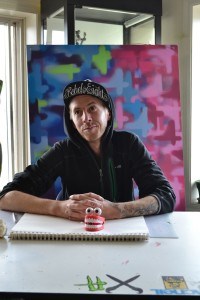
The first train car Ryan McQuaid ever painted was an orange coal hopper. It was about 5 p.m., and he concealed himself in a CN rail yard in an alcove created by a pile of rail ties. Just as he was finishing, a CN employee came around, and he almost got caught.
Since that first time, he’s continued to paint graffiti, and he might have done more, if he hadn’t been caught earlier this year.
March 31, after RCMP officers raided his home and studio as part of an investigation into graffiti that had popped up across town and the rail yard, McQuaid was charged with 11 counts of mischief, as well as other offences that were later dropped.
During the raid RCMP officers confiscated his laptop, paint supplies, a backpack and a radio that was once property of CN. McQuaid, a former member of the Jasper Artists Guild (JAG), had also tagged a number of businesses and municipality property across Jasper, and the vandalism had finally caught up with him.
Aug. 1 his fate was decided when the judge handed him a conditional discharge that included a small donation to a local charity, and one year’s probation.
“I’m not going to go anywhere near a train yard for a long, long, long time,” the 33-year-old said as he leaned back in his chair earlier this month. He sat outside his workplace, where he is second chef, and wore a ball cap and a wrist brace.
He had spent the last few months cleaning up the tags he had scrawled around the town, and was relieved with the outcome in court. He said he was glad the consequences weren’t more serious, and acknowledged how “stupid” the tagging had been.
He had trouble, however, explaining exactly why he did it.
It all started, he said, when he saw tags popping up around Jasper. He didn’t think they were particularity good, so he started leaving his mark beside them; it was “kind of a pride thing,” he said.
“There was a few nights where regretfully [I] walked home from the bar, or even from the train yard where I was painting, and I continued to ... hit everything in my wake,” he recalled.
He knew it was wrong, and that he would eventually get caught, but for some reason he didn’t stop.
“There was a few times when I thought ‘why am I doing this?’ and I continued to do it. Again it’s one of those—maybe it is an addiction, I don’t know.
“I think this whole thing ... needed to happen so I could realize what I was doing was completely stupid and wrong,” he said. “Obviously I have a lot of regret about it.”
But that regret does not mean that he doesn’t still love the idea of art in public spaces—especially train yards. McQuaid has been interested in graffiti since he was young, when a friend took him to a space where artists were free to paint. The constantly changing canvas captured his imagination, and when he was 17 he took his first tentative steps into graffiti.
In a lot of ways graffiti is a respected art form—JAG members like Alan Butler said they respected McQuaid’s work when he was part of the guild, and thought he had a lot of talent—but were troubled by the idea that graffiti is fundamentally based on defacing other’s property. McQuaid explained that a lot of former graffiti artists build respected careers doing legitimate aerosol work, but they all get their start tagging, bombing and painting pieces.
“You have to start from a certain place in order to get to another place—and that’s just sort of how graffiti works,” he said. “You could become a really great artist that uses aerosol but you’re never going to have that cred, because in order to get cred you need to be noticed in the streets.”
Building that cred often starts with tagging—simple signatures usually scrawled on public property that many argue have little or no artistic value—and builds from there. McQuiad argues that tagging is a necessary step to improvement as a graffiti artist—kind of like an apprenticeship. However, the underlying fact remains that it is illegal, and it does cost businesses money and time to remove.
Even if some graffiti is beautiful, legitimate art, it is still painted on other people’s property, and those people might not want it. McQuaid acknowledged that not everyone feels the same about graffiti, and do consider it nothing more than vandalism.
“Sometimes you know that what you’re doing is wrong, and obviously some people don’t like it. And I don’t want to disappoint people by making them think that I’m a vandal—because really I’m not,” he said.
Of course according to the law, and in the eyes of many of the people who were affected by his tagging, he is. After some consideration, McQuaid revised his statement.
“Ya, I’m a vandal and I used to ... deface property to some degree. But I always try to at least find the right space to do it in.”
Many accept arguments like McQuiad’s, and think graffiti enlivens dreary urban environments. CN worker Warren Waxer said he often enjoys the complex work he sees roll by on train cars, but he also said he doesn’t think people have a right put their art wherever they want.
Many also feel like graffiti is nothing more than pure vandalism. If someone were to graffiti on those people’s property, it is hard to argue that it is anything but disrespectful.
Despite his love of public art and grafitti, McQuaid said he’s done with tagging, and plans to refocus on his legal art in the future. If he follows the rules the judge set out, in one year his discharge will be considered absolute and he will be able to say he wasn’t committed of a criminal offence in court.
Trevor Nichols
